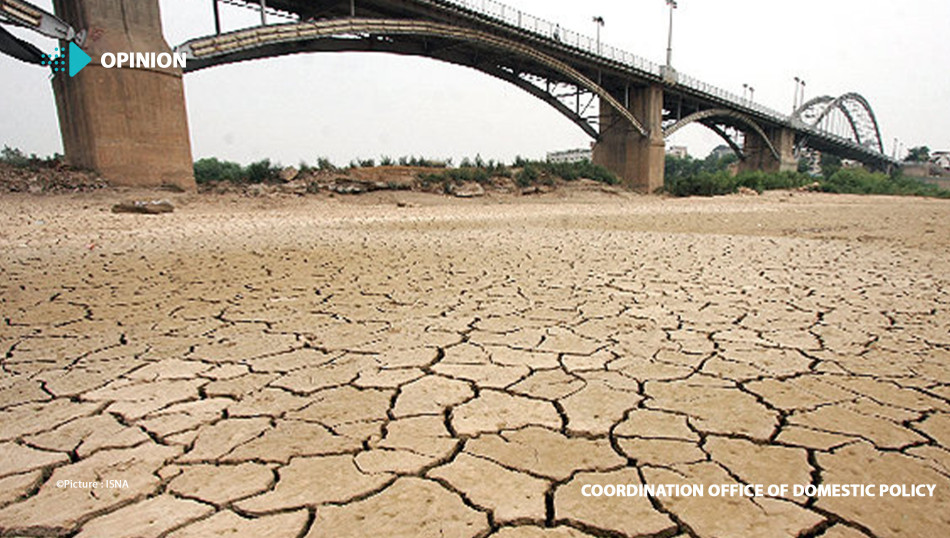Overview of the Water Crisis in Khuzestan
Despite the fact that Khuzestan possesses 33 % of Iran's surface water resources, the province is plagued by problems such as floods, air pollution, and drought, and the people's access to water resources is severely limited. Even though Khuzestan has sufficient water resources, it experiences a water crisis, which can be explained through several indicators.
Demographic and Economic Indicators
Khuzestan is located in southwestern Iran on an area of 64,057 square kilometres. According to the last census that took place in 2016, and it has a population of 4.7 million. The province has 27 districts and ranks second in terms of economic activities in the country. Considering the economic potential, it becomes the second most crucial province by providing 15.5 % of the Gross Domestic Product (GDP) after Tehran, which provides 20%, when oil revenues are included. If the revenues of oil are not included, it ranks fourth in the list. The unemployment rate in Khuzestan is above 14.5% despite all potential, whereas the rate reaches 40-45% in some districts. Moreover, according to the Ministry of Cooperatives, Labour, and Social Welfare, 24.5% of the population in the city suffers absolute poverty. In the province, 29.7% of households belong to the bottom three deciles of the society, and more than 58% of the population does not have a car. Despite the province's abundant surface water resources, 11 cities1 are experiencing drought, and 700 villages are without potable water.
The Significance of Khuzestan in Terms of Geostrategy, Geoeconomy, and Geopolitics
Khuzestan is one of the most significant provinces of the country in terms of politics, economics, and strategy. While it is the center of the region, which is known as “Strategic Energy Ellipse”, due to its oil and gas reserves, it also plays a crucial role in reaching major energy markets of South and East Asia through its geopolitical location. Khuzestan is one of the wealthiest provinces in terms of oil and natural gas resources, which constitute a significant part of Iran’s state revenues and export. Khuzestan is the country's second most significant province, with 33 petrochemical facilities in Mahshahr, four large oil refineries, and iron and steel manufacturing. In addition, one-third of the stream in the country is located in this province. All these factors increase its geoeconomic importance. While crucial harbors of the country such as Imam Khomeini, Mahshahr, and Hendijan that are located in Khuzestan, connect Iran to open waters, it also contributes to the country to engage in trade relations with other countries of the region. Its geographical proximity to the Gulf and the 650-kilometre Iraqi border are the other factors that expand the geostrategic significance of Khuzestan.
The Water Resources and Water Consumption in Khuzestan
Geographically, Khuzestan is one of the major water basins of the country, along with the Gulf, Arabian Sea, and several other provinces. It contains Big Karun, Karkheh and Zohreh-Jarrahibasins. The province receives an average of 330 mm of rainfall annually. According to the findings in 2020-2021, the annual rainfall in the Big Karun basin is 399 mm while Karkheh and Zohreh-Jarrahi basins receive 294 mm and 345 mm rainfall per year, respectively. The total capacity of the dam reservoirs in the province is 21.3 billion cubic meters, and their occupancy rate is 13.3 billion cubic meters. The total water storage volume of the seven large reservoir dams in Khuzestan is 16 billion cubic meters. As of December 25, 2021, the reservoir deficit rate in Khuzestan is 74%. The province has an exclusive position in the country with its annual inflow volume of 31 billion cubic meters and the water stored in the underground aquifers of 3 billion cubic meters. In terms of water consumption, it is possible to state that 31 billion cubic meters of water are consumed annually throughout the province. 90% of the surface water in Khuzestan is used in the agricultural sector, while the remaining 10% of this water is consumed by the industrial sector and as drinking water. The province consumes about 13% of the water used in the agricultural sector of the country.
Khuzestan in Terms of Hydro-Politics
The water basin in southwestern Iran is considered to be the most significant surface water resource of the country and provides abundant surface water to Khuzestan. This basin, which constitutes 26% of the main water basins in the country, includes crucial rivers such as Karun, Karkheh, Dez, Zohreh-Jarrahi. Khuzestan, one of the wealthiest provinces in the country in terms of water resources, owns numerous dams, including Dez, Shahid Abbaspour, Shohada, Karkheh, Khyrabad, Karun-3, Karun-4, and Masjed Soleyman. Furthermore, wetlands such as Shadegan and Horolazim are located in the province. These dams and wetlands are of great importance in the inter-provincial water supply. In addition to being geographically close to the Gulf and having rich freshwater resources, the start of some projects to transfer the water of the Gulf and the Arabian Sea to the center of the country is among the reasons that politicize the water in Khuzestan. Inter-basin water transfer or improperly constructed dams such as Gotvand Dam led to a decrease in water volume and paved the way for economic, social, and environmental consequences. This situation creates a sense of discrimination among the local people and triggers protests. During the protests in Gheyzaniyeh, Ahwaz, in 2020, it was brought to the agenda that access to drinking water has been problematic in Gheyzaniyeh, which has 83 villages and a population of 250,000, since the Revolution. Since water transfer projects in Karun proceed, and the management of water resources is based on lobbies and ethnic interests, the hydro-politics of Khuzestan has gotten increasingly complicated.
The Reasons Behind the Water Crisis in Khuzestan
There are numerous reasons behind the water crisis and drought in Khuzestan. These reasons include natural disasters, changing climatic conditions, and especially inadequate water resources management. In October 2018, the Abadan and Khorramshahr districts of the province faced severe water shortages. Most of the agricultural lands were destroyed, and countless palm trees were damaged in these districts due to severe water scarcity and saltwater. Another leading cause of the water crisis in Khuzestan is the evaporation of the water behind the dams in the province, such as the Karkheh Dam. Since the temperature reached 50° in the summer of 2021, approximately 70% of the water behind the Karkheh Dam evaporated. On the other hand, it is possible to state that the projects that transfer water from the Karun River to other regions deepen the water problem in Khuzestan.
While the Kouhrang-3 project is currently underway, the Behjatabad-1 and Behjatabad-2 tunnels carry water to Isfahan and Zayendeh Rud River. Moreover, the significant decrease in the rainfall and the water demand of the agricultural sector are other important factors that deepen the water crisis in the province. Despite the decreasing rainfall and increasing drought in Khuzestan, the cultivation of crops has nearly doubled in the province between 2007 and 2016. Considering the water consumed for sugar cane and paddy cultivation in Khuzestan, it is seen that paddy is cultivated on an area of approximately 85,000 hectares in the province.
Rent-Seeking Through Water and Conflict of Interest
The conflict of interest between the Environmental Protection Agency, the Ministry of Energy, the Ministry of Agriculture, and the Ministry of Petroleum plays an active role in the drying up of wetlands in Khuzestan. According to the statement of Adel Ala, Deputy Provincial Director of Environmental Protection in Khuzestan, “70% of the wetland in the province has been destroyed by the contractors of oil companies. Reservoirs 3, 4, and 5 of the wetlands were kept dry for the oil facilities to carry out their activities, and water was not allowed to enter these areas.” On the other hand, it is possible to say that the deputies have a great influence on several issues, including approved projects of the Ministry of Energy, which aims to transfer the water in Khuzestan to other regions, the policies of the Supreme Council of Water towards the region, water transfer to the central provinces or the pressures and negotiations for costly water projects in this province.
The conflict of interest of the relevant public institutions in Khuzestan can be described as "corruption and abuse of power”. As a matter of fact, the project coordinator, that is, the Khuzestan Water Authority, did not properly inspect the Khatam-al Anbiya Construction Headquarters, which carried out the project, and it caused a waste of capital. In addition, the fact that pipes used in these projects are defective and frequently replaced and that the different projects are started before the completion of existing ones also triggers the problem. Furthermore, it is claimed that the Ministry of Energy is the dominant power in the rent-seeking through the water resources in the province. In conclusion, the solution of the problem requires making a decision on this issue by opening an investigation in the Parliament about the institutionalized rent-seeking in the Ministry, and it also needs developing water management strategy, which is based on expert suggestions, to find a lasting solution for the water crisis in Khuzestan.
1 According to Iran's Administrative Division Law, settlements with a population of 10,000 or more are called cities.











